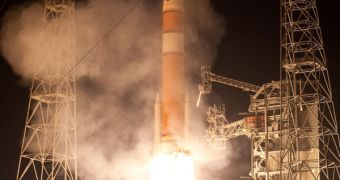Mission controllers handling the newly-launched Global Positioning System (GPS) IIF satellite say that the spacecraft has already sent back its first transmission, just a few hours after being launched.
GPS IIF-2 has already been renamed SVN-63. It will be operated by the US Air Force (USAF) as part of the country's GPS network. Boeing is under contract with the Air Force to construct 12 such new satellites, with the latest one being just the second in the series.
The signals the controllers received are meant to alert them that the spacecraft is now ready to begin on-orbit maneuvers and operational testing, and that everything is within normal operating parameters.
This satellite was launch from the Cape Canaveral Air Force Station (CCAFS), in Florida, on Saturday, July 16. It was carried to orbit aboard a United Launch Alliance (ULA) Delta IV delivery system, which took off at 2:41 am EDT (0641 GMT).
ULA is a joint venture between Boeing and Lockheed Martin. At this point, it handles all satellite launches for the USAF. The Delta IV rocket it produces is one of the most widely-used space systems in the world.
After launching SVN-63, mission managers received the first signals at 6:14 am EDT (1014 GMT). The data were received by a ground station located in the Indian Ocean. Experts at Boeing now plan to have all the systems on the satellite started within a couple of days.
“This satellite delivery continues Boeing's history of support to the Air Force, and joins the previous 39 mission-compliant satellites from the GPS Block I, Block II/IIA and GPS IIF missions represented by more than 35 years of teamwork,” Craig Cooning explained in a statement.
“GPS IIF contributes to building a robust GPS constellation by providing increased accuracy through improved atomic clock technology; a more jam-resistant military signal; and a more powerful and secure civilian signal to help commercial airline operations and search-and-rescue missions,” he added.
Cooning is the vice president and general manager of Boeing Space & Intelligence Systems (SIS) Division. He explained that SVN-63 was injected in a medium-Earth orbit (MEO). However, this is only provisional, until orbital maneuvers move to spacecraft to its final perch in space.
The new satellite is scheduled to complete on-orbit checkout this fall. At that time, Boeing mission controllers will hand over command of the spacecraft to the USAF 50th Space Wing and the 2nd Space Operations Squadron.
“GPS is a global utility providing highly accurate position, navigation and timing services at no cost to billions of people around the world,” a Boeing press release reads.
“Originally developed for military use, GPS has been adopted as the foundation of modern communications, with countless applications in aviation; agriculture; surveying and mapping; transportation and navigation; consumer commerce and communications; public safety and disaster relief, and much more,” the document concludes.

 14 DAY TRIAL //
14 DAY TRIAL //